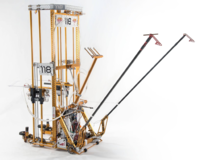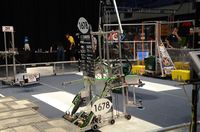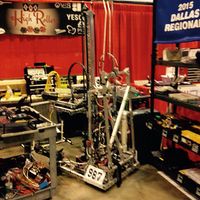2015 FRC Season
Contents
The Game[edit]
The 2015 game was called Recycle Rush, and it is widely considered to be the worst game in FRC history.
Game Manual on FIRST's website.
More details available on Wikipedia
Arena[edit]
The arena was a 27x54 foot carpeted field, split into two halves, red and blue. Each side had two white SCORING PLATFORMS which were 20" wide by 15'7" long. The area between the SCORING PLATFORMS was known as the AUTO ZONE. Along the middle of the field (between the red and blue halves) was a roughly 6" tall, 25" wide platform called the STEP. On each corner of the field were feeder stations where game pieces could be introduced to the field by human players.
Recycle Rush was unique in that robots from opposite alliances were not allowed to cross to the other side of the field. Additionally qualification matches didn't formally have winners and losers, so each team was only playing for their own scoring record.
Scoring[edit]
Recycle Rush was played by stacking Totes up to 6 high and placing them on the scoring platforms. Additional points could be added by placing a Recycle Bin on top of the stack with a further bonus for a pool noodle (called "Litter") being placed inside the opening on the recycling bin.
Autonomous Scoring[edit]
In the autonomous period, points were awarded for moving "sets" into the AUTO ZONE.
| Name | Description | Value |
|---|---|---|
| Robot Set | All three robots on alliances move into the AUTO ZONE in the first 15 seconds. | 4 |
| Tote Set | All three yellow totes are moved into the AUTO ZONE in the first 15 seconds | 6 |
| Container Set | All three recycling bins are moved into the AUTO ZONE in the first 15 seconds | 8 |
| Stacked Tote Set | All three yellow totes are stacked, moved into the AUTO ZONE, and fully released by any robots | 20 |
Teleoperated Scoring[edit]
Each stack of totes was worth 2 points, up to stack of 6 totes for 12 points. Adding a recycle bin on top of the stack was worth 4 points per level that it was placed on, effectively tripling the value of the stack it was placed on. A piece of litter placed in the recycling bin was worth an additional 6 points. The image to the right shows the possibles scores in Recycle Rush:
Coopertition Scoring[edit]
The third method of scoring was rarely used. If four yellow totes were placed on the STEP, they were worth 20 points to both alliances. If four yellow totes were stacked on the STEP, they were worth 40 points to both alliances.
Gameplay[edit]
At lower levels, Recycle Rush gameplay was boring and predictable, as alliances didn't interact with each other. Teams ran their usual routines, and stacked fairly consistent numbers of totes.
Due to the huge scoring impact of the recycle bins, in high level matches an alliance could almost guarantee victory by getting a majority of the 4 recycle bins preloaded on the STEP. The resulting Can Grabber arms race is described below. Because of the tight driving paths and risks presented by tall stacks of totes, many second pick robots were instructed to sit in the corner of the field for the duration of the match.
Competition[edit]
In 2015 there were 11,826 matches played across 110 events (counting the Championship as one event).
The highest ELO teams were:
| Rank | Team | Elo |
|---|---|---|
| 1 | 1114 | 2143 |
| 2 | 254 | 2136 |
| 3 | 1678 | 2049 |
| 4 | 2056 | 2035 |
| 5 | 1023 | 2023 |
| 6 | 987 | 2012 |
| 7 | 118 | 1981 |
| 8 | 2826 | 1970 |
| 9 | 548 | 1960 |
| 10 | 4488 | 1947 |
2015 Winning Alliance[edit]
| Team 118 | Team 1678 | Team 1671 | Team 5012 |
|---|---|---|---|
| CD Thread | |||
| CAD Link | CAD Link | ||
| Reveal Video | Season Recap Video | Reveal Video | Reveal Video |
2015 Finalist Alliance[edit]
| Team 987 | Team 2826 | Team 4265 | Team 2512 |
|---|---|---|---|
| Regional Highlights Video | Pre-Champs Video |
Team Paradox in 2015[edit]
Team Accomplishments[edit]
Main Article: Team Paradox in 2015
Main Article: 2015 Robot (Big Red)
2102's competitive record is below:
| Event | Average Qual Score | Rank | Alliance Selection | Playoffs Record | Awards |
|---|---|---|---|---|---|
| Central Valley Regional | 66.0 | 5th of 49 | 1st pick onto Alliance 2 by Team 701 | Finalist | Dean's List Finalist (Kylah C) Judges' Award |
| San Diego Regional | 88.0 | 4th of 59 | 3rd Alliance captain with 2485 and 1266 | Semifinalist | Woodie Flowers Finalist (John Gaby) Quality Award |
Engineering Problems and Solutions[edit]
2015 was unique in robot designs for many reasons. The most significant of which is that there was no limit to the starting size of a robot, with the only size limitation being placed on a robot's "transport configuration," meaning that robots were required to be able to fit within a 28 x 42 x 78in volume for transport. Because there was no robot-to-robot contact, bumpers were not required in 2015.
The unrestricted size limits led to some robots that spanned the entire field, such 148's Batman and Robin. Robin was a stationary machine that sat in front of the human player station creating stacks of six totes, while batman grabbed a recycling can and transported the completed stack to the SCORING PLATFORM. Although ruled illegal, there was originally a third component named "Alfred" which sat in the AUTO ZONE, pulling all three preloaded cans to it for an 8 point autonomous, and staging them for Batman to score.
Other teams such as 1657, 1750, and 1987 built conveyor belts that would continuously move totes from the feeder station, stack them, and score them. Unfortunately none of these designs proved competitively successful.
Curie Finals 1 shows good example of a can grabber race, 148's two-part robot, and 1114's highly effective intake and unconventional drivetrain.
Intakes[edit]
Because the game pieces were rigid, successful intakes were compliant, and able to conform to the orientation of the totes. 1114 built what might have been the most effective intake of the season, and the robot it was attached to had the highest elo of the season. The CAD view to the right shows 1114's intake; the spring-loaded outer rollers which feed into the rigid inner rollers.
Drivetrains[edit]
Because alliances didn't interact with each other, 2015 was unique in that otherwise impractical drivetrains became workable at high levels. Team 1114 had a Kiwi Drive, and team 148 had only two Mini CIMs driving the mobile portion of their robot. Mecanum drives also didn't provide their usual competitive disadvantage, because there were no pushing fights to be won or lost.
Lifting Totes[edit]
Most successful tote lifters used single-stage elevators with passive latches that fit under the flange of the tote. Many robots were U-shaped when viewed from above, such that stacks being built in the robot were fully contained in the body of the machine, to prevent them from being knocked over. Some teams copied successful stacking designs from 2003, such as team 67's.
Can Grabbers[edit]
At high levels of play, most captain and first pick robots were capable of creating four stacks of six, for a total of 2 (robots) x 4 (stacks) x 6 (totes) x 2 (points) = 96 points. Adding the three recycle bins from your side provided an additional 48 points. Beyond that, the only meaningful way to increase an alliance's score was to use the recycle bins in the middle. The only nearly guaranteed way to beat the opposing alliance was to get a majority of the cans in the middle before the other alliance did. This resulted in an arms race to build faster and faster "can burglars." This video shows the can races on Einstein field.
User themccannman on Cheif Delphi compiled a list of the fastest can grabbers at the Championship. Top 10 shown below
| Team | Time |
|---|---|
| 900/1114 Harpoons* | 105ms |
| 1678 | 175ms (158ms in the pits) |
| 971/254/973 cheesecake | 175ms |
| 148/1923 cheesecake | 175ms |
| 3310 | 205ms |
| 1918 | 225ms |
| 2056 | 250ms |
| 5027 | 266ms |
| 987 | 290ms |
| 3940 | 300ms |
*900/1114 Harpoons[edit]
The fastest can grabber in the world was never fielded. Team 1114 had started working on a "harpoon gun" can grabber in their pit at the Championship, which 900 saw and offered to replace their entire robot with a pit-built can grabbing machine. The harpoon gun was designed collaboratively overnight between 900 and 1114, and built between 6:45am and 2:00pm on the Saturday of competition using a Kit of Parts, stock metal, and spare parts. By the time the final machine was built, tested, and inspected, the alliance had already advanced to Einstein field. Due to the round-robin format of 2015 eliminations, a single low scoring match could remove an alliance from competition. The risk was considered too high to put the harpoon gun on the field, but the story is documented in this video and this thread.
Autonomous[edit]
The highest scoring autonomous in the world belonged to 2826 - Wave Robotics. The 2826 machine could acquire and hold all three recycling cans while acquiring and holding all three yellow totes, giving them the only consistent 28 point autonomous in the game. It can be seen here Pairing 987's fast can grabbers with 2826's auto pushed them as far as the finals on Einstein field, where 1678 and 118's can grabber advantage overcame 2826's autonomous advantage.
















